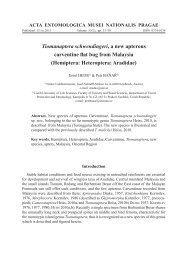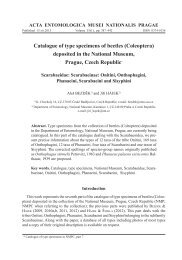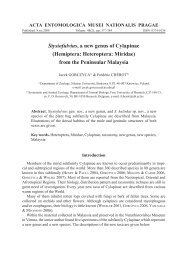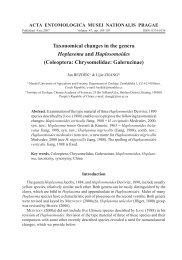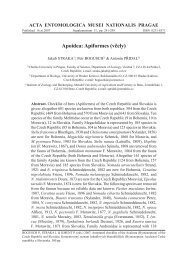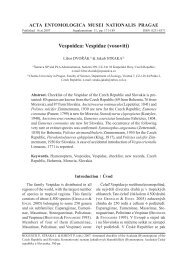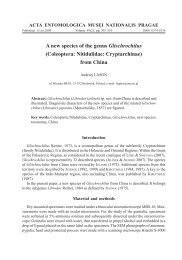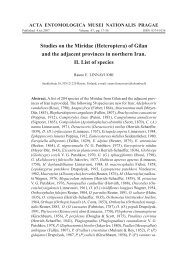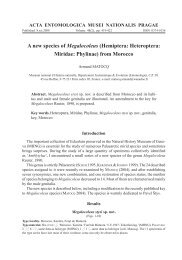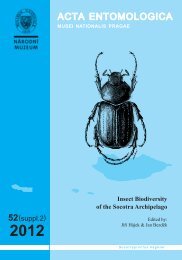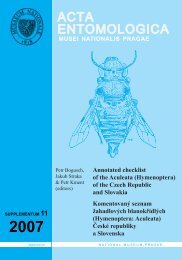Revision of the Palaearctic species of the Coccinella ...
Revision of the Palaearctic species of the Coccinella ...
Revision of the Palaearctic species of the Coccinella ...
You also want an ePaper? Increase the reach of your titles
YUMPU automatically turns print PDFs into web optimized ePapers that Google loves.
158<br />
KOVÁŘ: <strong>Coccinella</strong> transversoguttata <strong>species</strong> group and notes on o<strong>the</strong>r <strong>Coccinella</strong><br />
male genitalia show all details characteristic for C. transversoguttata (LIU 1962). IABLOKOFF-<br />
KHNZORIAN (1979) placed C. transversoguttata into <strong>the</strong> subgenus <strong>Coccinella</strong> s. str. and enumerated<br />
six sub<strong>species</strong>, four Nearctic, including C. nugatoria, and two <strong>Palaearctic</strong>, including<br />
biinterrupta which he upgraded from Mader’s aberration with <strong>the</strong> <strong>the</strong> authorship attributed to<br />
Mader. The latter sub<strong>species</strong>, C. t. biinterrupta Iablok<strong>of</strong>f-Khnzorian, 1979, described and<br />
keyed by IABLOKOFF-KHNZORIAN (1982), is undoubtedly identical with C. geminopunctata Liu,<br />
1962, and <strong>the</strong> second name has priority. FÜRSCH (1981) synonymized, without any comment,<br />
C. geminopunctata with C. transversoguttata and rejected ssp. biinterrupta Mader, 1930 in<br />
<strong>the</strong> sense <strong>of</strong> IABLOKOFF-KHNZORIAN (1979) on <strong>the</strong> basis <strong>of</strong> overlapping distribution with ‘normal<br />
form’. BIELAWSKI (1984) redescribed <strong>the</strong> nominate (sub)<strong>species</strong> based on Mongolian<br />
material and illustrated its habitus, <strong>the</strong> characteristic elytral pattern, lateral spot <strong>of</strong> pronotum,<br />
last ventrites and genitalia <strong>of</strong> both sexes.<br />
Key to <strong>the</strong> <strong>Palaearctic</strong> <strong>species</strong> <strong>of</strong> C. transversoguttata <strong>species</strong> group<br />
1 (2) Pale markings in anterior angles <strong>of</strong> pronotum triangular (Figs. 78-79). Elytra with isolated black spots. Apical<br />
hastate part <strong>of</strong> median lobe <strong>of</strong> aedeagus strongly dilated, nearly as wide as basal part, sinuate at sides (Fig.<br />
95). Preapical portion <strong>of</strong> sipho strikingly dilated at base, bearing three membranose swellings. ...................<br />
................................................................................................................. C. magnopunctata Rybakow, 1889<br />
2 (1) Pale markings in anterior angles <strong>of</strong> pronotum quadrangular (Figs. 75-77, 80-82). Elytra with at least two<br />
black spots connected (usually 4+5), if no spots connected, <strong>the</strong>n sutural margin <strong>of</strong> elytra red. Apical hastate<br />
portion <strong>of</strong> median lobe <strong>of</strong> aedeagus slightly dilated, at most 0.67 times as wide as basal portion (Figs. 93-94,<br />
96). Preapical portion <strong>of</strong> sipho not strikingly dilated at base, bearing two membranose swellings.<br />
3 (6) Sutural margin <strong>of</strong> elytra black. Spots ½ and 1 never connected. Tongue-shaped process <strong>of</strong> apical hastate<br />
portion <strong>of</strong> median lobe <strong>of</strong> aedeagus less than 0.5 times as long as <strong>the</strong> entire portion.<br />
4 (5) Elytra slightly convex, about 2.5-2.8 times as long as high. Apices <strong>of</strong> hind femora surpassing lateral margins<br />
<strong>of</strong> elytra. Apical hastate portion <strong>of</strong> median lobe rhomboidally dilated at base with sides concave (Fig. 93). .<br />
................................................................................................................................. C. marussii Kapur, 1973<br />
5 (4) Elytra strongly convex, about 2.1 times as long as high. Apices <strong>of</strong> hind femora reaching lateral margins <strong>of</strong><br />
elytra. Apical hastate portion <strong>of</strong> median lobe pear-shaped with sides sinuate (Fig. 94). ... C. hodeki sp. nov.<br />
6 (3) Sutural margin <strong>of</strong> elytra red. Spots ½ and 1 frequently connected, forming characteristic subbasal band.<br />
Tongue-shaped process <strong>of</strong> apical hastate portion <strong>of</strong> median lobe <strong>of</strong> aedeagus more than twice as long as <strong>the</strong><br />
hastate portion (Fig. 96). .................................. C. transversoguttata transversoguttata Faldermann, 1835<br />
Notes on some o<strong>the</strong>r <strong>Palaearctic</strong> <strong>species</strong> <strong>of</strong> <strong>Coccinella</strong><br />
I. <strong>Coccinella</strong> (<strong>Coccinella</strong>) tibetina Kapur, 1963 stat. restit.<br />
<strong>Coccinella</strong> tibetina Kapur, 1963: 34.<br />
<strong>Coccinella</strong> (s. str.) saucerottei ?ssp. tibetina: IABLOKOFF-KHNZORIAN (1979): 67 (catalogue).<br />
<strong>Coccinella</strong> (s. str.) saucerottii: IABLOKOFF-KHNZORIAN (1982): 366 (partim).<br />
<strong>Coccinella</strong> saucerottei: FÜRSCH (1981): 83 (partim).<br />
Described as a distinct <strong>species</strong> from Tibet by KAPUR (1963). Except for <strong>the</strong> type material<br />
(five specimens deposited in <strong>the</strong> British Museum <strong>of</strong> Natural History, London, and in <strong>the</strong><br />
Zoological Survey <strong>of</strong> India, Calcutta), no o<strong>the</strong>r material has been studied so far. IABLOKOFF-<br />
KHNZORIAN (1979, 1982) studied <strong>the</strong> original description and transferred C. tibetina into <strong>the</strong>



